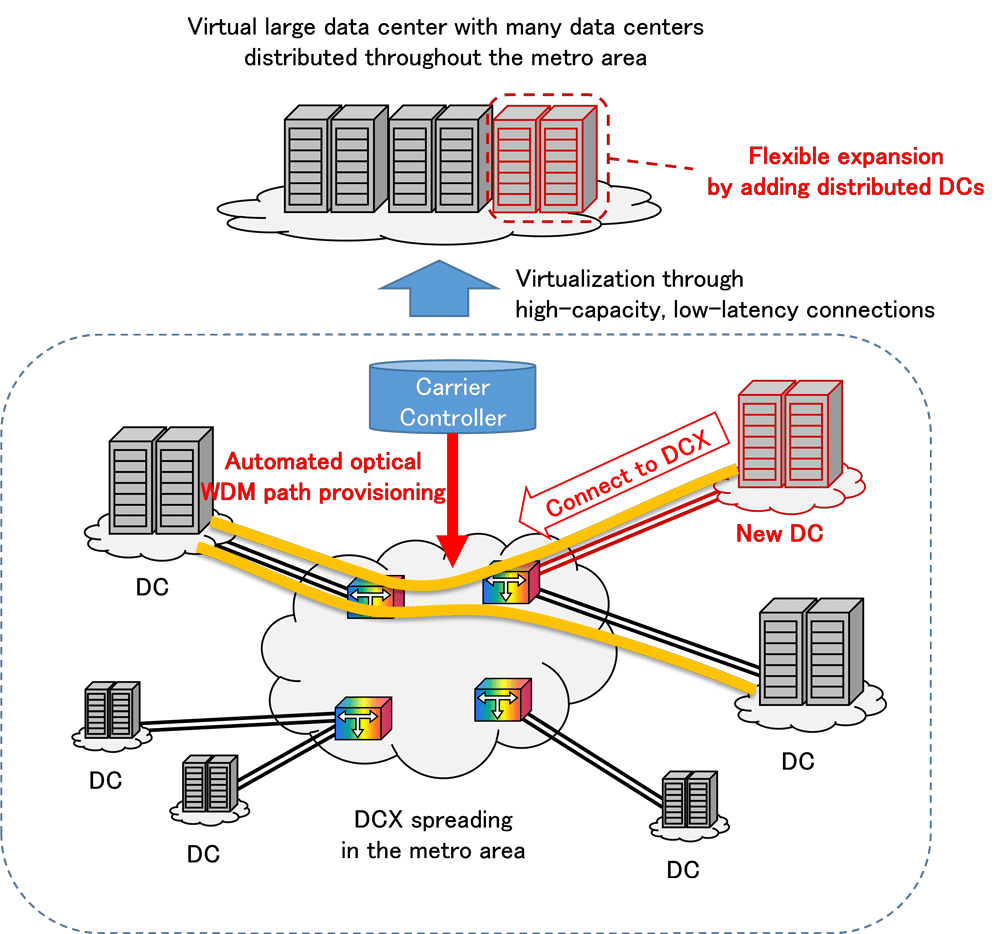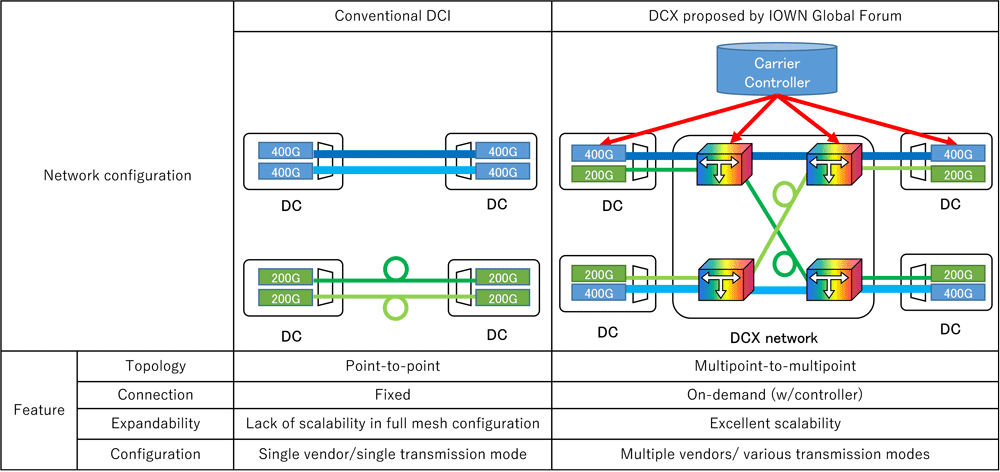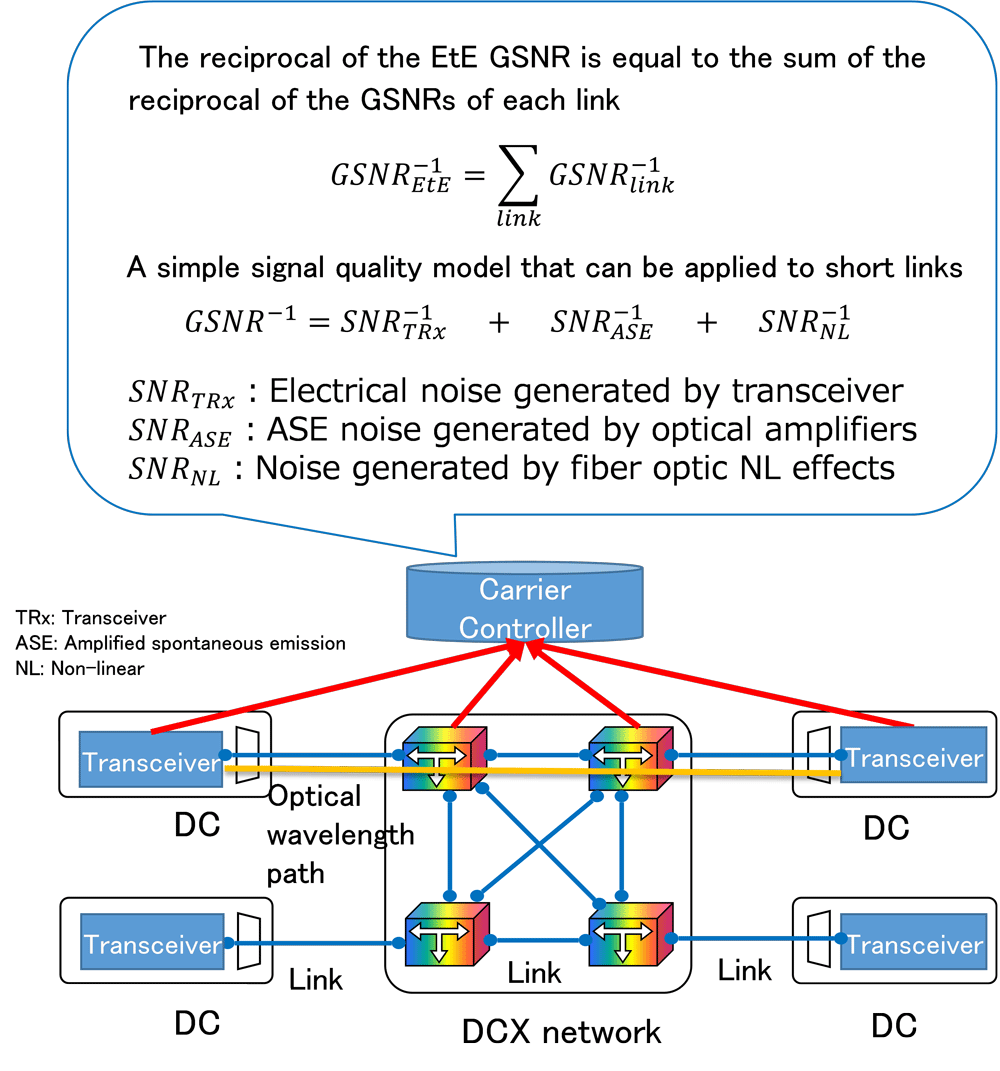Microsoft ends support for Internet Explorer on June 16, 2022.
We recommend using one of the browsers listed below.
- Microsoft Edge(Latest version)
- Mozilla Firefox(Latest version)
- Google Chrome(Latest version)
- Apple Safari(Latest version)
Please contact your browser provider for download and installation instructions.
October 13, 2023
NTT Corporation
NEC Corporation
Establishment and validation of optical wavelength path provisioning technology based on IOWN APN architecture for data center exchange services
~Reducing optical wavelength path design and configuration time from hours to minutes with automation technology~
Nippon Telegraph and Telephone Corporation (headquartered in Chiyoda-ku, Tokyo; Akira Shimada, President & CEO; hereinafter "NTT") and NEC Corporation (headquartered in Minato-ku, Tokyo; Takayuki Morita, President & CEO; hereinafter "NEC") conducted a field demonstration of optical wavelength path (*1) provisioning technology based on IOWN (*2) APN (*3) architecture defined at the IOWN Global Forum (*4) for on-demand high-capacity/low-latency connections among data centers through the National Science Foundation's (NSF) COSMOS testbed (*5) in the U.S. with Politecnico di Torino, Columbia University, Duke University, and Trinity College Dublin.
With this technology, carriers can design and configure optical wavelength paths in several minutes using an algorithm that automatically estimates the quality of the optical wavelength path, which used to take skilled workers more than two to three hours. This is an essential technology to enable data center exchange (DCX) services (Figure 1), which are proposed by NTT, NEC, and others in IOWN, to provide high-capacity, low-latency data center interconnection among distributed data centers by connecting necessary points with optical wavelength paths in an on-demand manner.
In October, NTT presented this result at Europe's largest international conference on optical communication technology in Scotland (49th European Conference on Optical Communications (ECOC) ), where it was selected as a best paper, and at the Telecom Infra Project's (TIP) (*6) Fyuz event (*7) in Spain.
 Figure 1. DCX service for high-capacity, low-latency communications between distributed data centers (DCs)
Figure 1. DCX service for high-capacity, low-latency communications between distributed data centers (DCs)
1. Background
Demand for data centers is increasing as services utilizing AI become more prevalent. Innovations in digital coherent (*8) and silicon photonics (*9) technologies have driven dramatic progress in DWDM (*10) transceiver capacity, miniaturization, and power savings in the optical transmission industry. This trend will be further accelerated by technologies such as coherent co-packaged devices in which digital signal processor and silicon photonics are implemented in a single package. Automated design and configuration techniques are required to configure the enormous number of optical wavelength paths with a DWDM transceiver.
There is also a new trend in construction plans for data centers to accommodate computing resources. While demand for data centers is increasing as AI services become more prevalent, data centers previously centralized in urban areas are now being relocated to suburban areas where power and infrastructure space are more abundant (Decentralization of data centers also reduces the risk of disasters). There is a growing need for optical wavelength paths to connect remote areas with high speed and low latency. Conventionally, data center interconnection (DCI) has been a simple point-to-point topology with devices configured by single vendor transceivers and a single transmission mode, which lacks scalability in full mesh configuration and makes it challenging to promote the decentralization of data centers on a large scale.
NTT has been collaborating with NEC, a member of the IOWN Global Forum, to verify technologies to implement data center exchange (DCX) services that directly connect many data centers built in metro areas via optical fiber. DCX requires the connection of devices from multiple vendors between many-to-many locations with various transmission modes suitable for link length and quality (Figure 2). Unlike conventional DCI, new technology development has been required to control devices from multiple vendors across the user access links and carrier links and to set up optical wavelength paths on demand with various transmission devices in different transmission modes suitable for the link's quality.
 Figure 2. Conventional DCI vs DCX
Figure 2. Conventional DCI vs DCX
2. Research results
2.1 On-demand optical wavelength path design technology
Optical signal quality degradation due to fiber propagation, optical amplifier noise, transceiver electrical noise, and optical switch must be calculated quickly to provide on-demand end-to-end optical wavelength path connections. Recently, the Gaussian noise model proposed by Politecnico di Torino has made it possible to calculate the signal quality degradation caused by optical fiber nonlinear optical effects during long-distance transmission in a short time, and many operators have verified its accuracy.
On the other hand, the dominant factors of signal quality degradation in short-distance transmission (100 to 200 km), which are the targets of DCX, are different from those in long-distance transmission, and it is necessary to analyze and model noise that has not been fully considered in optical transmission devices. To solve this issue, NTT has proposed a simple signal quality model that can be applied to short links by using the concept of the Gaussian noise model [1] and a method for designing and configuring optical wavelength paths on demand, even when crossing multiple user access links and carrier links and when using a wide variety of WDM transceivers [2] (Figure 3). NTT validated the model and the method with Politecnico di Torino and NEC, which has expertise in fiber nonlinear optical effects and commercial implementation of optical transmission systems. Furthermore, to implement this, NTT has designed an architecture and control plane protocol [3] that allows user site terminals and carrier equipment to coordinate and cooperate.
 Figure 3. An approach to select the optimal mode quickly based on the Gaussian noise approximation
Figure 3. An approach to select the optimal mode quickly based on the Gaussian noise approximation
2.2 Implementation and validation of the technologies with open platforms at the testbed
NEC has developed an open platform with Linux-based device software architecture that utilizes open interfaces, specifications, and architectures defined by Open ROADM MSA (*11), TIP, and the IOWN Global Forum. NEC leveraged Open ROADM MSA-compliant coherent TRxs to ensure data plane interconnectivity. For the hardware abstraction interface and network operating system (NOS) that controls user TRxs, NEC applied the TAI architecture (that hides the differences among various TRx form factors or vendors) and the Goldstone NOS that are under development openly in TIP OOPT. The APN functional architecture proposed in the IOWN Global Forum was adopted for the network architecture. NEC has been awarded a TIP requirements compliant Phoenix silver badge which certifies that their product has passed tests conducted by network operators, including approximately 160 specifications for commercial use defined by NTT, Telia, Telefonica, Vodafone, Deutsche Telekom, and MTN (*12).
NTT and NEC, with the cooperation of Columbia University, Duke University, and Trinity College Dublin, conducted a joint experiment to verify the operation of this method in the NSF COSMOS testbed (Figure 4). The COSMOS testbed is an advanced research platform deployed in Manhattan, New York City, which includes field fibers (provided by Boldyn and Crown Castle), optical amplifiers, and switches. On the COSMOS testbed, we constructed an experimental system simulating a DCX, consisting of a user data center, a carrier network, and an access fiber connecting them. We have confirmed that the optical wavelength path provisioning approach implemented by NTT and NEC allows the design and configuration of optical wavelength paths to be automatically completed within 6 minutes by selecting the appropriate transmission mode for each short and long route. We also confirmed that the error margin is small enough to provide commercial service.
 Figure 4. Proof-of-principle points at COSMOS testbed
Figure 4. Proof-of-principle points at COSMOS testbed
3. Prospect
We plan to promote standardization activities such as verification of optical amplifier characteristics estimation using transfer learning promoted by Trinity College Dublin and Duke University, and collaboration with GNPy, an open transmission design tool promoted by Politecnico di Torino. In cooperation with Orange and Chunghwa Telecom in the IOWN Global Forum, we will also contribute to the APN functional architecture. In particular, we plan to conduct a proof of concept using the Transport PCE (*13), an open controller for optical transmission network control, as a reference implementation model.
Endorsements
- Orange S.A.
Gilles Bourdon, Orange VP, Wireline Networks and Infrastructure
Eric Hardouin, Orange VP, Networks and Infrastructures Research
Orange is actively participating in organizations that promote openness, such as IOWN Global Forum, Telecom Infra Project, and OpenROADM. Along with openness, automation of network operations is a central issue. - Ioannis Tomkos, Professor (University of Patras), Fellow IEEE, Fellow IET, Fellow OPTICA
The recent achievement by NTT and NEC, in collaboration with their partners Politecnico di Torino, Columbia University, Duke University, and Trinity College Dublin within the framework of TIP, OpenROADM, and IOWN activities is a significant advancement in the evolution of optical networks operation. Decades long efforts on estimating accurately and fast the transmission quality of information carrying signals in high capacity long-haul backbone and shorter reach inter-datacenter networks, have led to an impressive demonstration at the COSMOS testbed of automated optical network connections provisioning within just 6 minutes (instead of hours). This achievement required important innovations associated with the development of specialized models for the estimation of quality of signal transmissions in shorter reach links that have unique characteristics, as well as the design of a control plane architecture and protocols that allow the end-user terminals and network equipment at data centers to coordinate efficiently. I am impressed with what was demonstrated at the field-trial and I hope to see real deployments in the future taking advantage of the associated innovations.
Reference:
[1]T. Mano, A. D'Amico, E. Virgillito, G. Borraccini, Y. Huang, K. Kitamura, K. Anazawa, A. Masuda, H. Nishizawa, T. Wang, K. Asahi, and V. Curri, "Accuracy of Nonlinear Interference Estimation on Launch Power Optimization in Short-Reach Systems with Field Trial," in Proceedings of the European Conference on Optical Communication (ECOC) 2022, paper We3B.1.
https://opg.optica.org/abstract.cfm?URI=ECEOC-2022-We3B.1
[2]T. Mano, T. Ferreira de Lima, Y. Huang, Z. Wang, W. Ishida, E. Ip, A. D'Amico, S. Okamoto, T. Inoue, H. Nishizawa, V. Curri, G. Zussman, D. Kilper, T. Chen, T. Wang, K. Asahi, K. Takasugi, "First Field Demonstration of Automatic WDM Optical Path Provisioning over Alien Access Links for Data Center Exchange" in Proceedings of the European Conference on Optical Communication (ECOC) 2023, paper Tu.B.5.2.
[3]H. Nishizawa, T. Sasai, T. Inoue, K. Anazawa, T. Mano, K. Kitamura, Y. Sone, T. Inui, and K. Takasugi, "Dynamic optical path provisioning for alien access links: Architecture, demonstration, and challenges" IEEE Communications Magazine, Vol. 61, Issue 4, April 2023, pp. 136–142.
https://doi.org/10.1109/MCOM.006.2200567
*1Optical wavelength path
A connection using a specific wavelength between optical transceivers. By occupying wavelengths between optical transceivers, low-latency and high-capacity communication are possible.
*2Innovative Optical and Wireless Network (IOWN)
IOWN stands for Innovative Optical and Wireless Network, a concept proposed by NTT for networks and information processing infrastructure. Since January 2021, IP Infusion has been a General Member of the IOWN Global Forum (Established in Jan 2020), an international forum promoted by companies and organizations supporting the IOWN vision.
https://www.rd.ntt/e/iown/
https://iowngf.org/
*3All-Photonic Network (APN)
An innovative network based on photonics technology whose architecture is being openly developed by the IOWN Global Forum. The IOWN Global Forum is developing the APN to provide direct optical paths between any location on demand to implement use cases of the IOWN.
https://www.rd.ntt/e/iown/
*4IOWN Global Forum
A new industry forum that promotes the realization of a new communication infrastructure consisting of all-photonics networks, including silicon photonics, edge computing, and wireless distributed computing through the development of new technologies, frameworks, technical specifications, and reference designs to meet the data and information processing demands of the coming era.
https://iowngf.org/
*5National Science Foundation's (NSF) COSMOS testbed
A city-scale advanced wireless testbed funded by the NSF in order to support real-world experimentation on next-generation wireless technologies and applications.
https://www.cosmos-lab.org/
*6Telecom Infra Project (TIP)
The TIP is a collaborative telecom community. Launched in February 2016, TIP started with the goal of accelerating the pace of innovation in the telecom industry.
https://telecominfraproject.com/
*7Fyuz
An event where leaders of open and disaggregated network solutions and the wider telecoms industry will gather to share and discuss recipes for success.
https://www.fyuz.events/
*8Digital coherent
Digital coherent technology is a transmission method that combines digital signal processing and coherent detection. Coherent detection can capture the amplitude and phase of light by using the light interference between the received signal light and local laser light on the receiving side. This enables polarization division multiplexing and phase modulation and can improve frequency utilization efficiency. In addition, coherent detection allows precise equalization of optical signal distortion by using digital signal processing and significantly improves reception sensitivity.
*9Silicon photonics
An optical circuit fabrication technology using the fabrication process for silicon-based large-scale integration (LSI). Optical circuits with a waveguide width of several hundred nanometers are available. The technology is considered to be the foundation of large-scale photonic integrated circuits because large-scale silicon wafers can be employed.
*10Wavelength Division Multiplexing (WDM)/Dense WDM (DWDM)
WDM technology increases transmission capacity by simultaneously passing light of different wavelengths (colors) through a single optical fiber. Dense WDM (DWDM) is densely multiplexed to achieve ultra-high-capacity optical transmission.
*11Open ROADM MSA
The OpenROADM Multi-Source Agreement (MSA) is a collaborative effort between carriers and vendors to create and promote an open, disaggregated, and efficient optical networking ecosystem for flexible, scalable, and fully operational networks supporting various services and applications.
http://openroadm.org/
*12NEC awarded the Telecom Infra Project's "Silver Badge" for its disaggregated 400G transponder solution
https://www.nec.com/en/press/202310/global_20231012_02.html
*13Transport PCE
The Transport PCE is an OpenDaylight controller feature whose primary function is to control the infrastructure of an optical transport network using a non-proprietary South Bound Interface (SBI).
https://docs.opendaylight.org/en/latest/release-notes/projects/transportpce.html
About NTT
NTT contributes to a sustainable society through the power of innovation. We are a leading global technology company providing services to consumers and business as a mobile operator, infrastructure, networks, applications, and consulting provider. Our offerings include digital business consulting, managed application services, workplace and cloud solutions, data center and edge computing, all supported by our deep global industry expertise. We are over $95B in revenue and 330,000 employees, with $3.6B in annual R&D investments. Our operations span across 80+ countries and regions, allowing us to serve clients in over 190 of them. We serve over 75% of Fortune Global 100 companies, thousands of other enterprise and government clients and millions of consumers.
About NEC Corporation
NEC Corporation has established itself as a leader in the integration of IT and network technologies while promoting the brand statement of "Orchestrating a brighter world." NEC enables businesses and communities to adapt to rapid changes taking place in both society and the market as it provides for the social values of safety, security, fairness and efficiency to promote a more sustainable world where everyone has the chance to reach their full potential. For more information, visit NEC at https://www.nec.com
Media contact
NTT
Public Relations
nttrd-pr@ml.ntt.com
Information is current as of the date of issue of the individual press release.
Please be advised that information may be outdated after that point.
NTT STORY
WEB media that thinks about the future with NTT










